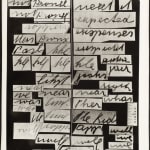Albert S. Osborn
Album of Handwriting Analysis Samples from the Lindbergh-Hauptmann Trial, 1935
Silver prints (15)
Each 10 1/2 x 13 1/2 inches
Sold
Further images
-
(View a larger image of thumbnail 1
)

-
(View a larger image of thumbnail 2
)

-
(View a larger image of thumbnail 3
)

-
(View a larger image of thumbnail 4
)

-
(View a larger image of thumbnail 5
)

-
(View a larger image of thumbnail 6
)

-
(View a larger image of thumbnail 7
)

-
(View a larger image of thumbnail 8
)

In 1932, famed aviator Charles Lindbergh’s 20-month-old son was taken from the family home in New Jersey. The kidnapping of the Lindbergh baby became a national sensation, compounded by the...
In 1932, famed aviator Charles Lindbergh’s 20-month-old son was taken from the family home in New Jersey. The kidnapping of the Lindbergh baby became a national sensation, compounded by the leaving of a ransom note and the discovery, two months later, of the child’s body. The manhunt, which was formally taken over by the FBI in October of 1933, lasted for two years, culminating in the arrest of German immigrant Bruno Richard Hauptmann.
The trial took place in Flemington, New Jersey and received extensive coverage from national media. According to contemporary reports, every hotel room in the town was booked, and Hauptmann’s attorney was paid for by the New York Daily Mirror in exchange for the rights to his story. Eight different handwriting experts were brought in to testify for the prosecution, including Albert S. Osborn.
This album was compiled by Osborn and donated to the Library of the Association of the Bar of the City of New York (from where it was deaccessioned). It consists of photographs documenting evidence from and materials related to the trial. It includes photographs of four ransom notes to Lindbergh and his wife, several pages of word comparisons taken from the different letters, and side-by-sides showing writing from the ransom notes compared with Hauptmann’s own handwriting from “dictated specimens.”
The last three pages include photographs of the $10 gold certificate which ultimately led to Hauptmann’s arrest, reproductions of photographs used in newspaper articles, and, on the final page, two newspaper headlines proclaiming the role of handwriting analysis in solving the case. “Handwriting Sealed Doom Of Bruno, Juror Reveals,” reads one, while the other notes “OSBORN AIDED.”
The inside front cover includes a nameplate from Osborn and a notice from the Association of the Bar dated to April 18, 1935, two months after the closing of the trail. Osborn was an early leader in the science of questioned document examination, publishing the book Questioned Documents in 1910. In September of 1942, he founded the American Society of Questioned Document Examiners, which still exists today.
This album serves as a fascinating and graphically-compelling example of photographic handwriting analysis in a high-profile case.
The trial took place in Flemington, New Jersey and received extensive coverage from national media. According to contemporary reports, every hotel room in the town was booked, and Hauptmann’s attorney was paid for by the New York Daily Mirror in exchange for the rights to his story. Eight different handwriting experts were brought in to testify for the prosecution, including Albert S. Osborn.
This album was compiled by Osborn and donated to the Library of the Association of the Bar of the City of New York (from where it was deaccessioned). It consists of photographs documenting evidence from and materials related to the trial. It includes photographs of four ransom notes to Lindbergh and his wife, several pages of word comparisons taken from the different letters, and side-by-sides showing writing from the ransom notes compared with Hauptmann’s own handwriting from “dictated specimens.”
The last three pages include photographs of the $10 gold certificate which ultimately led to Hauptmann’s arrest, reproductions of photographs used in newspaper articles, and, on the final page, two newspaper headlines proclaiming the role of handwriting analysis in solving the case. “Handwriting Sealed Doom Of Bruno, Juror Reveals,” reads one, while the other notes “OSBORN AIDED.”
The inside front cover includes a nameplate from Osborn and a notice from the Association of the Bar dated to April 18, 1935, two months after the closing of the trail. Osborn was an early leader in the science of questioned document examination, publishing the book Questioned Documents in 1910. In September of 1942, he founded the American Society of Questioned Document Examiners, which still exists today.
This album serves as a fascinating and graphically-compelling example of photographic handwriting analysis in a high-profile case.







